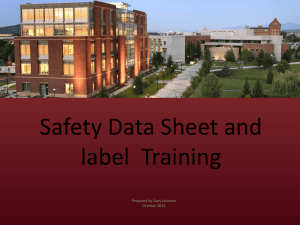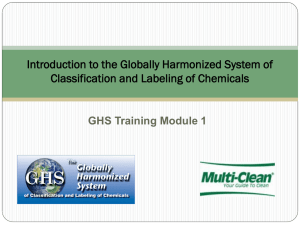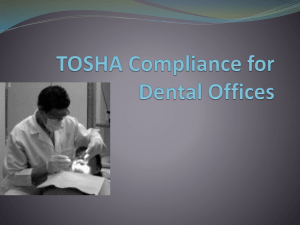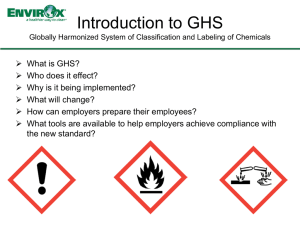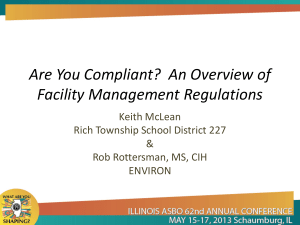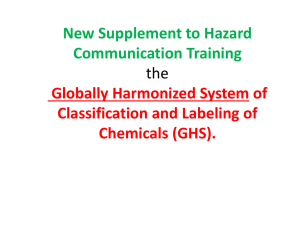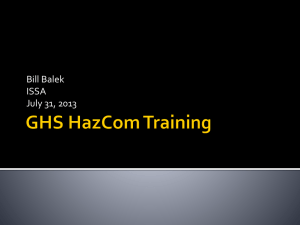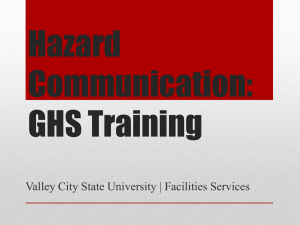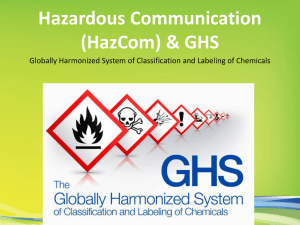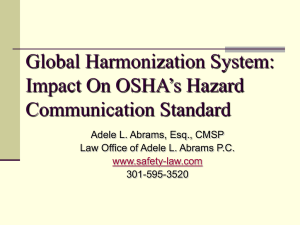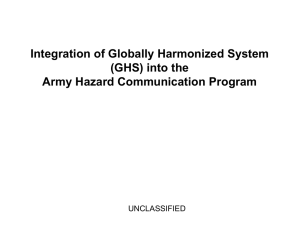GHS - Compliance Services International
advertisement
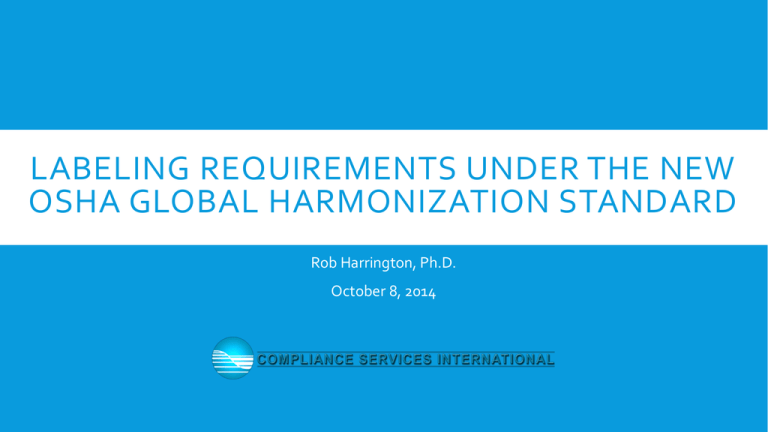
LABELING REQUIREMENTS UNDER THE NEW OSHA GLOBAL HARMONIZATION STANDARD Rob Harrington, Ph.D. October 8, 2014 OVERVIEW OSHA issued the final rule to revise 29 CFR 1910.1200 (Hazard Communication Standard) that appeared in the Federal Register on 3/26/12. The goal was to integrate components of the UN Global Harmonization Standard (GHS) into the OSHA HazCom standard. The rule modifies MSDS (Now SDS) requirements, labeling, classifications, and requires retraining of all employees. OVERVIEW Hazard classification: Provides specific criteria for classification of health and physical hazards od substances as well as mixtures. Labels: Chemical manufacturers and importers will be required to provide a label that includes a harmonized signal word, pictogram, and hazard statement for each hazard class and category. Precautionary statements must also be provided. Safety Data Sheets: SDS will now be required to have a specified 16-section format. WHY DEVELOP A GLOBALLY HARMONIZED STANDARD? Companies around the world are major importers/exporters of chemicals Missing, contradictory or incomplete information on chemicals may lead to reduced protections for workers and public. Large number of varying requirements around the world create confusion, shipping issues and potential barriers to trade A harmonized and consistent approach has benefits both in terms of protection and trade. GHS PROJECT: INTERNATIONAL MANDATE The goal of establishing a globally harmonized system for hazard communication was established in 1992 at the UN Conference on the Environment and Development - “Rio Earth Summit”. The Mandate: “A globally harmonized hazard classification and compatible labelling system, including national safety data sheets and easily understandable symbols, should be available, if feasible, by the year 2000.” U.N. PURPLE BOOK – THE BASIS FOR GHS OSHA FINAL RULE GHS IMPLEMENTATION TIMELINE 12/1/13: All employees must be trained on new label elements and SDS format (better be done at this point!) 6/1/15: Manufacturers and distributors must comply with all modified provisions [labels, SDS] except that distributors have until 12/1/15 to provide revised labels for all products shipped. 6/1/16: OSHA enforcement starts: Employers must update all labels and HazCom programs, provide additional training for workers on newly identified physical or health hazards During transition period, employers can comply with old or new standard as far as labels and SDSs. BASIC ELEMENTS OF GHS Classification Criteria - each substance /mixture needs to be classified: Health and environmental hazards Physical hazards Hazard Communication - apply the results of the classification process to: Labels Safety Data Sheets CLASSIFICATION "Classification" means to: identify the relevant data regarding the hazards of a chemical review data to ascertain the hazards associated with the chemical decide whether the chemical will be classified as hazardous according to the definition of hazardous chemical Hazard classification is a self-classification process – manufactures and importers must classify each chemical/mixture, determine the appropriate hazard class and category based on the evaluation of full range of available data/evidence No testing is required CLASSIFICATION Classifications are based on specific procedures outlined in the regulations. Data is gathered on the substance/mixture and compared to the criteria on the standard The resulting classification is referenced to the labeling requirements and the resulting information is to appear on the labels and Safety Data Sheets (SDS) HEALTH/ENVIRONMENTAL HAZARD CATEGORIES Acute Toxicity Skin Corrosion/Irritation Serious Eye Damage/Eye Irritation Respiratory or Skin Sensitization Germ Cell Mutagenicity Carcinogenicity Reproductive Toxicity Target Organ Systemic Toxicity – Single and Repeated Dose Aspiration Toxicity Hazardous to the Aquatic Environment (non-mandatory) PHYSICAL HAZARDS Explosive Flammability – gases, aerosols, liquids, solids Oxidizer – liquid, solid, gases Self-Reactive Pyrophoric – liquids, solids Self-Heating Organic Peroxides Corrosive to Metals Gases Under Pressure Water-Activated Flammable Gases REQUIRED LABEL ELEMENTS Product identifier Supplier identifier (name, address, phone) Hazard pictograms Signal words (Warning or Danger) Hazard statements Precautionary information Supplemental information is optional Pictograms HEALTH HAZARD FLAME EXCLAMATION MARK GAS CYLINDER FLAME OVER CIRCLE CORROSION ENVIRONMENT EXPLODING BOMB SKULL & CROSSBONES • Acute Toxicity (fatal or toxic) • Acute toxicity (harmful) • Eye or skin irritant • Skin sensitizer • Respiratory tract irritant • Narcotic effects • Hazardous to the ozone layer • Corrosive to skin • Eye damage • Corrosive to metals • Flammable • Pyrophoric • Self-heating • Water activated flammable gas • Self-reactive • Organic peroxide • Oxidizer Gases under pressure • Explosive • Self-reactive • Organic peroxide • • • • • • Carcinogen Mutagen Reproductive toxicity Respiratory sensitizer Target organ toxicity Aspiration toxicity • Aquatic Toxicity (non-mandatory) Categories of Acute Oral Toxicity Category 1 LD50 < 5 mg/kg Category 2 Category 3 Category 4 LD50 > 5 to < 50 mg/kg LD50 > 50 to < 300 mg/kg LD50 > 300 to < 2000 mg/kg DANGER DANGER DANGER WARNING Fatal if swallowed Fatal if swallowed Toxic if swallowed Harmful if swallowed EXAMPLE Cleaning product Calculated acute oral LD50 of 200 mg/kg (Category 3) No specific treatment or antidote Severe eye irritant (Category 2A) Not classified under any other category Ultra-Super-Kleen Pictograms Product Identifier DANGER Signal word Toxic if swallowed. Causes serious eye irritation. Hazard Statements Wash Hands thoroughly after handling. Do not eat, drink or smoke when using this product. Wear eye protection (specify). Precautionary Statements-Prevention If swallowed: Rinse mouth. Immediately call a doctor of poison control center. If in eyes: Rinse cautiously with water for several minutes. Remove contact lenses , if present and easy to do so. Continue rinsing. If eye irritation persists: Get medical attention. Precautionary Statements-Response Store Locked up. Dispose of in accordance with local, state and federal regulations. Precautionary Statements- Storage & Disposal The Kleen Corporation, 1234 Main Street, Chicago, Illinois 60608, 312-312-3121 Supplier Name, Address and Phone Number FOR PROFESSIONAL USE ONLY SAFETY DATA SHEETS - 16 SECTION 1. Identification 2. Hazard(s) identification 3. Composition/information on ingredients 4. First-aid measures 5. Fire-fighting measures 6. Accidental release measures 7. Handling and storage 8. Exposure control/personal protection SAFETY DATA SHEETS - 16 SECTION 9. Physical and chemical properties 10. Stability and reactivity 11. Toxicological information 12. Ecological information 13. Disposal considerations 14. Transport information 15. Regulatory information 16. Other information GHS LABELS VS. GHS GHS Labeling is a very prescriptive process that requires the product be classified and labeled based on the strict guidelines (hazard based) Pictograms Location and font size not specified CONSUMER LABELS Consumer Consumer More flexible assessment of risk (risk based); labeling statements are generally more flexible No pictogram required (usually) Location and font size requirements well defined; depends on many variables such as container size PROFESSIONAL LABEL Ultra-Super-Kleen DANGER Toxic if swallowed. Causes serious eye irritation. Wash Hands thoroughly after handling. Do not eat, drink or smoke when using this product. Wear eye protection (specify). If swallowed: Rinse mouth. Immediately call a doctor of poison control center. If in eyes: Rinse cautiously with water for several minutes. Remove contact lenses , if present and easy to do so. Continue rinsing. If eye irritation persists: Get medical attention. Store Locked up. Dispose of in accordance with local, state and federal regulations. The Kleen Corporation, 1234 Main Street, Chicago, Illinois 60608, 312-312-3121 FOR PROFESSIONAL USE ONLY CONSUMER LABEL FRONT PANEL Ultra-Super-Kleen CAUTION: Harmful if swallowed. Causes serious eye irritation. See back panel for additional information. BACK PANEL Wash Hands thoroughly after handling. Do not eat, drink or smoke when using this product. Avoid contact with skin and eyes. FIRST AID: If swallowed: Rinse mouth then immediately call a doctor of poison control center. If in eyes: Rinse with water for 15 minutes. If eye irritation persists seek medical attention. Keep out of the reach of children The Kleen Corporation, Chicago, Illinois 60608 CAN YOU USE CONSUMER PRODUCTS IN THE WORKPLACE? OSHA permits the use of consumer labeled products in the workplace. OSHA requires the employer to assess if consumer products in the workplace are used in the same manner (frequency and duration) as a consumer would use them. Products used in a manner similar to consumers does not require any special training or SDS be obtained. Example – a glass cleaner used on your computer screen once a week HAZCOM EXEMPTION FOR CONSUMER PRODUCTS §1910.1200 Hazard communication. (b) Scope and application. (6) This section does not apply to: (ix) Any consumer product or hazardous substance, as those terms are defined in the Consumer Product Safety Act and Federal Hazardous Substances Act respectively, where the employer can show that it is used in the workplace for the purpose intended by the chemical manufacturer or importer of the product, and the use results in a duration and frequency of exposure which is not greater than the range of exposures that could reasonably be experienced by consumers when used for the purpose intended CONSUMER PRODUCT REQUIREMENTS WHEN USED MORE FREQUENTLY IN THE WORKPLACE For example, a consumer labeled glass cleaner used by the cleaning person on 100 windows daily This use greatly exceeds the frequency/duration of a typical consumer OSHA requires that in this case, the employee be trained on the use of the product A SDS is required if available (or documentation that it is not available) It is acceptable to create you own SDS if you know enough about the product. FOR MORE INFORMATION A Guide to The Globally Harmonized System of Classification and Labelling of Chemicals (GHS) https://www.osha.gov/dsg/hazcom/ghs.html Small Entity Compliance Guide for Employers That Use Hazardous Chemicals https://www.osha.gov/Publications/OSHA3695.pdf HCS/HazCom 2012 Final Rule & Appendices https://www.osha.gov/dsg/hazcom/ghs-final-rule.html UN Purple Book http://www.unece.org/fileadmin/DAM/trans/danger/publi/ghs/ghs_rev05/English/STSG-AC10-30-Rev5e.pdf Rob Harrington, Ph.D. Compliance Services International rharrington@complianceservices.com http://www.complianceservices.com/ 630-222-7624
